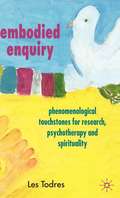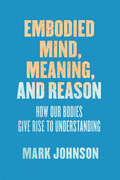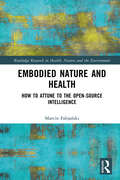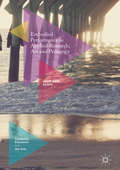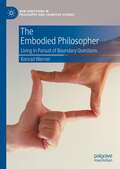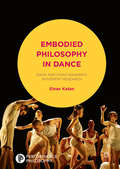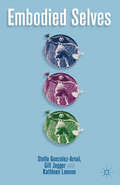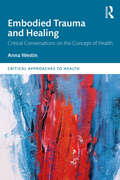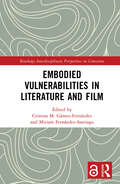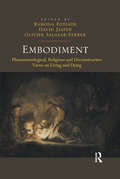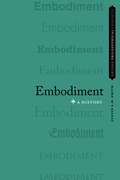- Table View
- List View
Embodied Enquiry: Phenomenological Touchstones for Research, Psychotherapy and Spirituality
by L. TodresDrawing on a particular emphasis within the phenomenological tradition as exemplified by Maurice Merleau-Ponty and Eugene Gendlin, this book considers the role of the lived body as a way of knowing and being within three practical contexts that illustrate some of the nuances of embodied enquiry: qualitative research, psychotherapy, spirituality.
Embodied Idealism: Merleau-Ponty's Transcendental Philosophy
by Joseph C. BerendzenEmbodied Idealism argues that Maurice Merleau-Ponty's early thought - primarily as found in The Structure of Behavior and Phenomenology of Perception - stands as a form of transcendental idealism. This interpretation runs against the grain of much of the Merleau-Ponty scholarship, and opposing interpretations are not without support. Merleau-Ponty is at points highly critical of idealism in his early works. Also, his emphasis on embodiment would seem to run counter to the idealist view that the mental is central to reality. Joseph Berendzen shows that these points can be accommodated within a transcendental idealist interpretation. Merleau-Ponty's overt criticisms of idealism are aimed at specific aspects of idealist theories that are not obligatory aspects of idealism in general. Rather, his critique is typically aimed at a specific version of intellectualist idealism associated with his teacher Léon Brunschvicg. In spite of his overt criticisms of idealism, Merleau-Ponty's early philosophy holds that our experience is inextricably structured by our minds. Furthermore, he holds that reality is ontologically dependent on the mind, yet in a manner that also allows for a sense in which reality is mind-independent. It is crucial to this interpretation that Merleau-Ponty's emphasis on embodiment leads to a unique view of embodied consciousness and subjectivity that supports a novel form of idealism, rather than motivating an anti-idealist position. Thus, his transcendental idealism is genuinely an embodied idealism.
Embodied Idealism: Merleau-Ponty's Transcendental Philosophy
by Joseph C. BerendzenEmbodied Idealism argues that Maurice Merleau-Ponty's early thought - primarily as found in The Structure of Behavior and Phenomenology of Perception - stands as a form of transcendental idealism. This interpretation runs against the grain of much of the Merleau-Ponty scholarship, and opposing interpretations are not without support. Merleau-Ponty is at points highly critical of idealism in his early works. Also, his emphasis on embodiment would seem to run counter to the idealist view that the mental is central to reality. Joseph Berendzen shows that these points can be accommodated within a transcendental idealist interpretation. Merleau-Ponty's overt criticisms of idealism are aimed at specific aspects of idealist theories that are not obligatory aspects of idealism in general. Rather, his critique is typically aimed at a specific version of intellectualist idealism associated with his teacher Léon Brunschvicg. In spite of his overt criticisms of idealism, Merleau-Ponty's early philosophy holds that our experience is inextricably structured by our minds. Furthermore, he holds that reality is ontologically dependent on the mind, yet in a manner that also allows for a sense in which reality is mind-independent. It is crucial to this interpretation that Merleau-Ponty's emphasis on embodiment leads to a unique view of embodied consciousness and subjectivity that supports a novel form of idealism, rather than motivating an anti-idealist position. Thus, his transcendental idealism is genuinely an embodied idealism.
Embodied Metaphors in Film, Television, and Video Games: Cognitive Approaches (Routledge Research in Cultural and Media Studies)
by Kathrin FahlenbrachIn cognitive research, metaphors have been shown to help us imagine complex, abstract, or invisible ideas, concepts, or emotions. Contributors to this book argue that metaphors occur not only in language, but in audio visual media well. This is all the more evident in entertainment media, which strategically "sell" their products by addressing their viewers’ immediate, reflexive understanding through pictures, sounds, and language. This volume applies cognitive metaphor theory (CMT) to film, television, and video games in order to analyze the embodied aesthetics and meanings of those moving images.
Embodied Metaphors in Film, Television, and Video Games: Cognitive Approaches (Routledge Research in Cultural and Media Studies)
by Kathrin FahlenbrachIn cognitive research, metaphors have been shown to help us imagine complex, abstract, or invisible ideas, concepts, or emotions. Contributors to this book argue that metaphors occur not only in language, but in audio visual media well. This is all the more evident in entertainment media, which strategically "sell" their products by addressing their viewers’ immediate, reflexive understanding through pictures, sounds, and language. This volume applies cognitive metaphor theory (CMT) to film, television, and video games in order to analyze the embodied aesthetics and meanings of those moving images.
Embodied Mind, Meaning, and Reason: How Our Bodies Give Rise to Understanding
by Mark JohnsonMark Johnson is one of the great thinkers of our time on how the body shapes the mind. This book brings together a selection of essays from the past two decades that build a powerful argument that any scientifically and philosophically satisfactory view of mind and thought must ultimately explain how bodily perception and action give rise to cognition, meaning, language, action, and values. A brief account of Johnson’s own intellectual journey, through which we track some of the most important discoveries in the field over the past forty years, sets the stage. Subsequent chapters set out Johnson’s important role in embodied cognition theory, including his cofounding (with George Lakoff) of conceptual metaphor theory and, later, their theory of bodily structures and processes that underlie all meaning, conceptualization, and reasoning. A detailed account of how meaning arises from our physical engagement with our environments provides the basis for a nondualistic, nonreductive view of mind that he sees as most congruous with the latest cognitive science. A concluding section explores the implications of our embodiment for our understanding of knowledge, reason, and truth. The resulting book will be essential for all philosophers dealing with mind, thought, and language.
Embodied Mind, Meaning, and Reason: How Our Bodies Give Rise to Understanding
by Mark JohnsonMark Johnson is one of the great thinkers of our time on how the body shapes the mind. This book brings together a selection of essays from the past two decades that build a powerful argument that any scientifically and philosophically satisfactory view of mind and thought must ultimately explain how bodily perception and action give rise to cognition, meaning, language, action, and values. A brief account of Johnson’s own intellectual journey, through which we track some of the most important discoveries in the field over the past forty years, sets the stage. Subsequent chapters set out Johnson’s important role in embodied cognition theory, including his cofounding (with George Lakoff) of conceptual metaphor theory and, later, their theory of bodily structures and processes that underlie all meaning, conceptualization, and reasoning. A detailed account of how meaning arises from our physical engagement with our environments provides the basis for a nondualistic, nonreductive view of mind that he sees as most congruous with the latest cognitive science. A concluding section explores the implications of our embodiment for our understanding of knowledge, reason, and truth. The resulting book will be essential for all philosophers dealing with mind, thought, and language.
Embodied Mind, Meaning, and Reason: How Our Bodies Give Rise to Understanding
by Mark JohnsonMark Johnson is one of the great thinkers of our time on how the body shapes the mind. This book brings together a selection of essays from the past two decades that build a powerful argument that any scientifically and philosophically satisfactory view of mind and thought must ultimately explain how bodily perception and action give rise to cognition, meaning, language, action, and values. A brief account of Johnson’s own intellectual journey, through which we track some of the most important discoveries in the field over the past forty years, sets the stage. Subsequent chapters set out Johnson’s important role in embodied cognition theory, including his cofounding (with George Lakoff) of conceptual metaphor theory and, later, their theory of bodily structures and processes that underlie all meaning, conceptualization, and reasoning. A detailed account of how meaning arises from our physical engagement with our environments provides the basis for a nondualistic, nonreductive view of mind that he sees as most congruous with the latest cognitive science. A concluding section explores the implications of our embodiment for our understanding of knowledge, reason, and truth. The resulting book will be essential for all philosophers dealing with mind, thought, and language.
Embodied Mind, Meaning, and Reason: How Our Bodies Give Rise to Understanding
by Mark JohnsonMark Johnson is one of the great thinkers of our time on how the body shapes the mind. This book brings together a selection of essays from the past two decades that build a powerful argument that any scientifically and philosophically satisfactory view of mind and thought must ultimately explain how bodily perception and action give rise to cognition, meaning, language, action, and values. A brief account of Johnson’s own intellectual journey, through which we track some of the most important discoveries in the field over the past forty years, sets the stage. Subsequent chapters set out Johnson’s important role in embodied cognition theory, including his cofounding (with George Lakoff) of conceptual metaphor theory and, later, their theory of bodily structures and processes that underlie all meaning, conceptualization, and reasoning. A detailed account of how meaning arises from our physical engagement with our environments provides the basis for a nondualistic, nonreductive view of mind that he sees as most congruous with the latest cognitive science. A concluding section explores the implications of our embodiment for our understanding of knowledge, reason, and truth. The resulting book will be essential for all philosophers dealing with mind, thought, and language.
Embodied Mind, Meaning, and Reason: How Our Bodies Give Rise to Understanding
by Mark JohnsonMark Johnson is one of the great thinkers of our time on how the body shapes the mind. This book brings together a selection of essays from the past two decades that build a powerful argument that any scientifically and philosophically satisfactory view of mind and thought must ultimately explain how bodily perception and action give rise to cognition, meaning, language, action, and values. A brief account of Johnson’s own intellectual journey, through which we track some of the most important discoveries in the field over the past forty years, sets the stage. Subsequent chapters set out Johnson’s important role in embodied cognition theory, including his cofounding (with George Lakoff) of conceptual metaphor theory and, later, their theory of bodily structures and processes that underlie all meaning, conceptualization, and reasoning. A detailed account of how meaning arises from our physical engagement with our environments provides the basis for a nondualistic, nonreductive view of mind that he sees as most congruous with the latest cognitive science. A concluding section explores the implications of our embodiment for our understanding of knowledge, reason, and truth. The resulting book will be essential for all philosophers dealing with mind, thought, and language.
Embodied Mind, Meaning, and Reason: How Our Bodies Give Rise to Understanding
by Mark JohnsonMark Johnson is one of the great thinkers of our time on how the body shapes the mind. This book brings together a selection of essays from the past two decades that build a powerful argument that any scientifically and philosophically satisfactory view of mind and thought must ultimately explain how bodily perception and action give rise to cognition, meaning, language, action, and values. A brief account of Johnson’s own intellectual journey, through which we track some of the most important discoveries in the field over the past forty years, sets the stage. Subsequent chapters set out Johnson’s important role in embodied cognition theory, including his cofounding (with George Lakoff) of conceptual metaphor theory and, later, their theory of bodily structures and processes that underlie all meaning, conceptualization, and reasoning. A detailed account of how meaning arises from our physical engagement with our environments provides the basis for a nondualistic, nonreductive view of mind that he sees as most congruous with the latest cognitive science. A concluding section explores the implications of our embodiment for our understanding of knowledge, reason, and truth. The resulting book will be essential for all philosophers dealing with mind, thought, and language.
Embodied Nature and Health: How to Attune to the Open-source Intelligence (Routledge Research in Health, Nature and the Environment)
by Marcin FabjańskiThis book describes how, as a species our survival and capacity to flourish depends on realizing the intimate relationship of humans with nature through active, embodied participation with nature. Living within the physicality of the planet is not a limitation, rather it is our liberation. Full realization of the consequences of this relationship, through embodied action, can liberate us from ego-dependence and transform us into a community of interdependent and flourishing beings. Embodied Nature and Health: How to Attune to the Open-source Intelligence describes a systems analysis of presence-centered cultivation of well-being through particular ways of being physically and mentally active in relation to nature that aims at helping the individual attune to natures’ rhythms. The systems analysis proposes the hypothesis of the Open-source Intelligence: an intelligence which originates from the placement of individual organisms in the tissue and the process of life. This framework draws upon and integrates contemporary research into the human–nature relationship and human well-being, and ancient philosophies that were developed prior to the Cartesian gap between the mind and the body, as well as using an auto-ethnographic approach dervied from the experience of the author. The proposed system highlights a practical approach to well-being, based on research into human attention and its effective usage in daily life. The book outlines a methodology that can be used in schools, as a basis of training in sports, as well as in the field of self-development, and highlights the necessity to develop a new, non-abusive relationship with the natural environment. This novel, multi-discipline, first-of-its-kind research book will be of strong interest to experts and academics in the fields of physical activity, education, ecology, and philosophy.
Embodied Nature and Health: How to Attune to the Open-source Intelligence (Routledge Research in Health, Nature and the Environment)
by Marcin FabjańskiThis book describes how, as a species our survival and capacity to flourish depends on realizing the intimate relationship of humans with nature through active, embodied participation with nature. Living within the physicality of the planet is not a limitation, rather it is our liberation. Full realization of the consequences of this relationship, through embodied action, can liberate us from ego-dependence and transform us into a community of interdependent and flourishing beings. Embodied Nature and Health: How to Attune to the Open-source Intelligence describes a systems analysis of presence-centered cultivation of well-being through particular ways of being physically and mentally active in relation to nature that aims at helping the individual attune to natures’ rhythms. The systems analysis proposes the hypothesis of the Open-source Intelligence: an intelligence which originates from the placement of individual organisms in the tissue and the process of life. This framework draws upon and integrates contemporary research into the human–nature relationship and human well-being, and ancient philosophies that were developed prior to the Cartesian gap between the mind and the body, as well as using an auto-ethnographic approach dervied from the experience of the author. The proposed system highlights a practical approach to well-being, based on research into human attention and its effective usage in daily life. The book outlines a methodology that can be used in schools, as a basis of training in sports, as well as in the field of self-development, and highlights the necessity to develop a new, non-abusive relationship with the natural environment. This novel, multi-discipline, first-of-its-kind research book will be of strong interest to experts and academics in the fields of physical activity, education, ecology, and philosophy.
Embodied Performance as Applied Research, Art and Pedagogy
by Julie-Ann ScottThis book follows a physically disabled researcher's journey from stigmatized embodiment on her way to creating accessible storytelling performances. These unique performances function not only as traditional, peer-reviewed forms of critical qualitative research, but also as ‘narrative teaching productions’ that guide students and their audiences in the pursuit of social justice and equality. The book begins by developing the author's personal standpoint, and provides an evocative discussion of the multiple perceptions and identities experienced by those with disabled bodies. It negotiates how performance research can be created and conducted within the confines of course learning objectives, moves through complications encountered in research design and data collection, and explores a range of insightful responses from community members, social activists, and performance critics, as well as more traditional academic audiences. Critical autoethnographic personal narratives, performance scripts, and poetry are used to illuminate struggles over legitimate methodological practice and storytelling performance pedagogy. Each chapter confronts the fear of mortality that presses us to stigmatize those who remind us of our inescapably vulnerable embodiments and offers hope for an inclusive, adaptable culture. The book will be compelling reading for scholars in Performance Studies, Disability Studies, Cultural Studies, Narrative Methodology, Ethnography, Higher Education, Autoethnography, Creative Nonfiction and everyone interested embodiment and/or storytelling for social change.Please visit www.uncwstorytelling.org/chapter-summaries-1 to access supplementary material for the book.
Embodied Performance as Applied Research, Art and Pedagogy
by Julie-Ann ScottThis book follows a physically disabled researcher's journey from stigmatized embodiment on her way to creating accessible storytelling performances. These unique performances function not only as traditional, peer-reviewed forms of critical qualitative research, but also as ‘narrative teaching productions’ that guide students and their audiences in the pursuit of social justice and equality. The book begins by developing the author's personal standpoint, and provides an evocative discussion of the multiple perceptions and identities experienced by those with disabled bodies. It negotiates how performance research can be created and conducted within the confines of course learning objectives, moves through complications encountered in research design and data collection, and explores a range of insightful responses from community members, social activists, and performance critics, as well as more traditional academic audiences. Critical autoethnographic personal narratives, performance scripts, and poetry are used to illuminate struggles over legitimate methodological practice and storytelling performance pedagogy. Each chapter confronts the fear of mortality that presses us to stigmatize those who remind us of our inescapably vulnerable embodiments and offers hope for an inclusive, adaptable culture. The book will be compelling reading for scholars in Performance Studies, Disability Studies, Cultural Studies, Narrative Methodology, Ethnography, Higher Education, Autoethnography, Creative Nonfiction and everyone interested embodiment and/or storytelling for social change.Please visit www.uncwstorytelling.org/chapter-summaries-1 to access supplementary material for the book.
The Embodied Philosopher: Living in Pursuit of Boundary Questions (New Directions in Philosophy and Cognitive Science)
by Konrad WernerThe book is the first formulation of a meta-philosophical scheme rooted in the embodied cognition paradigm. The latter views subjects capable of cognition and experience as living, embodied creatures coupled with their environments. On the other hand, the emergence of experimental philosophy has given rise to a new context in which philosophers have begun to search for a more thorough definition of philosophical competence. The time is ripe for these two trends to join their efforts. Therefore, the book discusses what it means for a human being thought of as a living subject to pursue philosophy. In this context, in contrast to the existing literature, philosophical competence must not be conflated with competence in philosophy. The former is a skill or attitude. The book refers to this peculiar attitude as the recognition of one’s epistemic position.
Embodied Philosophy in Dance: Gaga and Ohad Naharin's Movement Research (Performance Philosophy)
by Einav Katan-SchmidRepresenting the first comprehensive analysis of Gaga and Ohad Naharin's aesthetic approach, this book follows the sensual and mental emphases of the movement research practiced by dancers of the Batsheva Dance Company. Considering the body as a means of expression, Embodied Philosophy in Dance deciphers forms of meaning in dance as a medium for perception and realization within the body. In doing so, the book addresses embodied philosophies of mind, hermeneutics, pragmatism, and social theories in order to illuminate the perceptual experience of dancing. It also reveals the interconnections between physical and mental processes of reasoning and explores the nature of physical intelligence.
Embodied Selves
by Stella Gonzalez-Arnal, Gill Jagger and Kathleen LennonThis interdisciplinary collection explores the role the body plays in constituting our sense of self, signalling the interplay between material embodiment, social meaning, and material and social conditions.
Embodied Trauma and Healing: Critical Conversations on the Concept of Health (Critical Approaches to Health)
by Anna WestinWhat if philosophy could solve the psychological puzzle of trauma? Embodied Trauma and Healing argues just that, suggesting that one might be needed in order to understand the other. The book demonstrates how the body-mind problem that haunted Descartes was addressed by phenomenologists, whilst also proposing that the human experience is lived subjectively as embodied consciousness. Throughout this book, the author suggests that the phenomenological tools that are used to explore the body can also be an effective way to discuss the physical and mental aspects of embodied trauma. Drawing on the work of Paul Ricœur, Maurice Merleau-Ponty and Emmanuel Lévinas, the book outlines a phenomenological approach to the embodied and relational subject. It offers a reading of embodied trauma that can connect it to wider conversations in psychological underpinnings of trauma through Peter Levine’s somatic research and Bessel van der Kolk’s embodied remembering. Connecting to the analytic tradition, the book suggests that phenomenology can unify both language-based and body-based therapeutic practice. It also presents a compelling discussion that ties the embodied experience of relation in trauma to the wider causal factors of social suffering and relational rupture, intergenerational trauma and the trauma of land, as informed by phenomenology. Embodied Trauma and Healing is essential reading for researchers within the fields of philosophy, psychology and medical humanities for it actively engages with contemporary configurations of trauma theory and recent research developments in healing and mental disorder diagnosis.
Embodied Trauma and Healing: Critical Conversations on the Concept of Health (Critical Approaches to Health)
by Anna WestinWhat if philosophy could solve the psychological puzzle of trauma? Embodied Trauma and Healing argues just that, suggesting that one might be needed in order to understand the other. The book demonstrates how the body-mind problem that haunted Descartes was addressed by phenomenologists, whilst also proposing that the human experience is lived subjectively as embodied consciousness. Throughout this book, the author suggests that the phenomenological tools that are used to explore the body can also be an effective way to discuss the physical and mental aspects of embodied trauma. Drawing on the work of Paul Ricœur, Maurice Merleau-Ponty and Emmanuel Lévinas, the book outlines a phenomenological approach to the embodied and relational subject. It offers a reading of embodied trauma that can connect it to wider conversations in psychological underpinnings of trauma through Peter Levine’s somatic research and Bessel van der Kolk’s embodied remembering. Connecting to the analytic tradition, the book suggests that phenomenology can unify both language-based and body-based therapeutic practice. It also presents a compelling discussion that ties the embodied experience of relation in trauma to the wider causal factors of social suffering and relational rupture, intergenerational trauma and the trauma of land, as informed by phenomenology. Embodied Trauma and Healing is essential reading for researchers within the fields of philosophy, psychology and medical humanities for it actively engages with contemporary configurations of trauma theory and recent research developments in healing and mental disorder diagnosis.
Embodied VulnerAbilities in Literature and Film (Routledge Interdisciplinary Perspectives on Literature)
by Gámez-Fernández, Cristina M Miriam Fernández-SantiagoEmbodied VulnerAbilities in Literature and Film includes a collection of essays exploring the ways in which recent literary and filmic representations of vulnerability depict embodied forms of vulnerability across languages, media, genres, countries, and traditions in the late 20th and early 21st centuries. The volume gathers 12 chapters penned by scholars from Japan, the USA, Canada, and Spain which look into the representation of vulnerability in human bodies and subjectivities. Not only is the array of genres covered in this volume significant— from narrative, drama, poetry, (auto)documentary, or film— in fiction and nonfiction, but also the varied cultural and linguistic coordinates of the literary and filmic texts scrutinized—from the USA, Canada, Spain, France, the Middle East, to Japan. Readers who decide to open the cover of this volume will benefit from becoming familiar with a relatively old topic— that of vulnerability— from a new perspective, so that they can consider the great potential of this critical concept anew.
Embodied VulnerAbilities in Literature and Film (Routledge Interdisciplinary Perspectives on Literature)
Embodied VulnerAbilities in Literature and Film includes a collection of essays exploring the ways in which recent literary and filmic representations of vulnerability depict embodied forms of vulnerability across languages, media, genres, countries, and traditions in the late 20th and early 21st centuries. The volume gathers 12 chapters penned by scholars from Japan, the USA, Canada, and Spain which look into the representation of vulnerability in human bodies and subjectivities. Not only is the array of genres covered in this volume significant— from narrative, drama, poetry, (auto)documentary, or film— in fiction and nonfiction, but also the varied cultural and linguistic coordinates of the literary and filmic texts scrutinized—from the USA, Canada, Spain, France, the Middle East, to Japan. Readers who decide to open the cover of this volume will benefit from becoming familiar with a relatively old topic— that of vulnerability— from a new perspective, so that they can consider the great potential of this critical concept anew.
Embodiment: Phenomenological, Religious and Deconstructive Views on Living and Dying
by Ramona Fotiade David Jasper Olivier Salazar-FerrerThis book examines a number of landmark shifts in our account of the relationship between human and divine existence, as reflected through the perception of time and corporeal experience. Drawing together some of the best scholars in the field, this book provides a representative cross-section of influential trends in the philosophy of religion (e.g. phenomenology, existential thought, Biblical hermeneutics, deconstruction) that have shaped our understanding of the body in its profane and sacred dimensions as site of conflicting discourses on presence and absence, subjectivity and the death of the subject, mortality, resurrection and eternal life.
Embodiment: Phenomenological, Religious and Deconstructive Views on Living and Dying
by Ramona Fotiade David Jasper Olivier Salazar-FerrerThis book examines a number of landmark shifts in our account of the relationship between human and divine existence, as reflected through the perception of time and corporeal experience. Drawing together some of the best scholars in the field, this book provides a representative cross-section of influential trends in the philosophy of religion (e.g. phenomenology, existential thought, Biblical hermeneutics, deconstruction) that have shaped our understanding of the body in its profane and sacred dimensions as site of conflicting discourses on presence and absence, subjectivity and the death of the subject, mortality, resurrection and eternal life.
Embodiment: A History (Oxford Philosophical Concepts)
by Justin E. H. SmithEmbodiment--defined as having, being in, or being associated with a body--is a feature of the existence of many entities, perhaps even of all entities. Why entities should find themselves in this condition is the central concern of the present volume. The problem includes, but also goes beyond, the philosophical problem of body: that is, what the essence of a body is, and how, if at all, it differs from matter. On some understandings there may exist bodies, such as stones or asteroids, that are not the bodies of any particular subjects. To speak of embodiment by contrast is always to speak of a subject that variously inhabits, or captains, or is coextensive with, or even is imprisoned within, a body. The subject may in the end be identical to, or an emergent product of, the body. That is, a materialist account of embodied subjects may be the correct one. But insofar as there is a philosophical problem of embodiment, the identity of the embodied subject with the body stands in need of an argument and cannot simply be assumed. The reasons, nature, and consequences of the embodiment of subjects as conceived in the long history of philosophy in Europe as well as in the broader Mediterranean region and in South and East Asia, with forays into religion, art, medicine, and other domains of culture, form the focus of these essays. More precisely, the contributors to this volume shine light on a number of questions that have driven reflection on embodiment throughout the history of philosophy. What is the historical and conceptual relationship between the idea of embodiment and the idea of subjecthood? Am I who I am principally in virtue of the fact that I have the body I have? Relatedly, what is the relationship of embodiment to being and to individuality? Is embodiment a necessary condition of being? Of being an individual? What are the theological dimensions of embodiment? To what extent has the concept of embodiment been deployed in the history of philosophy to contrast the created world with the state of existence enjoyed by God? What are the normative dimensions of theories of embodiment? To what extent is the problem of embodiment a distinctly western preoccupation? Is it the result of a particular local and contingent history, or does it impose itself as a universal problem, wherever and whenever human beings begin to reflect on the conditions of their existence? Ultimately, to what extent can natural science help us to resolve philosophical questions about embodiment, many of which are vastly older than the particular scientific research programs we now believe to hold the greatest promise for revealing to us the bodily basis, or the ultimate physical causes, of who we really are?
